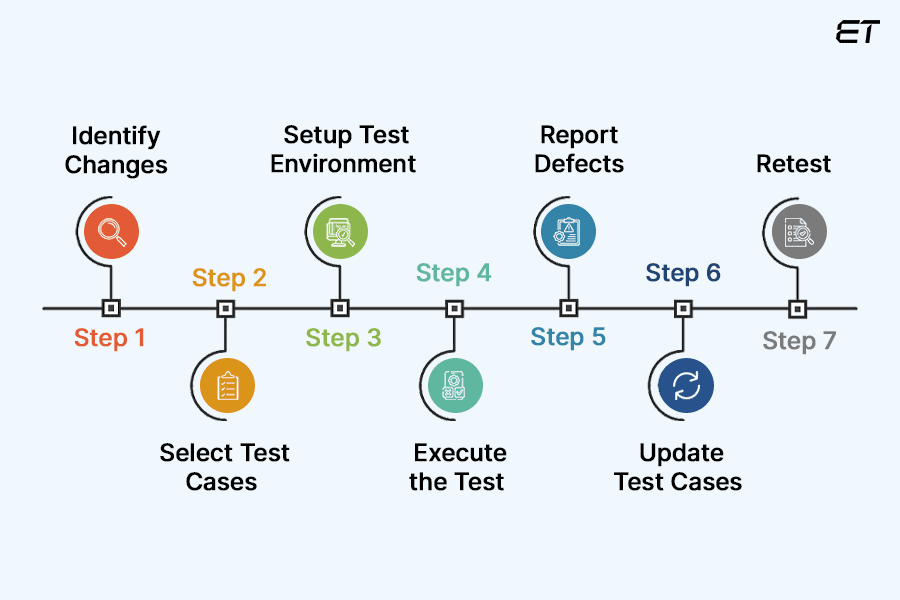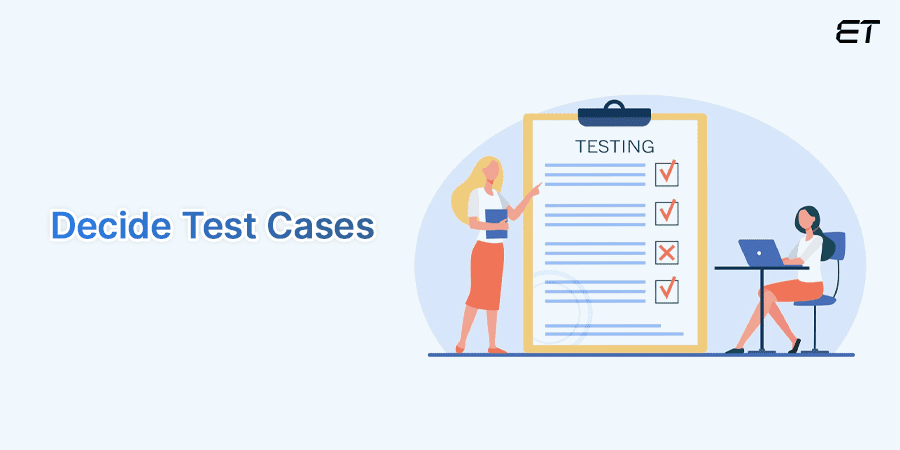
Regression Testing: Concept, Process, and Benefits
What is the one thing that’s constant about software? Developers keep on adding or modifying new features. This way, they ensure the overall integrity of the digital product. And that’s precisely where regression testing steps in.
It’s true that unit testing leads the chart with 63% popularity in the QA cycle. However, you just can’t overlook the significance of a regression test in software development.
Simply put, regression testing is the process of re-executing a subset of test cases to ensure that previously developed software performs correctly after changes. If this sounds a bit too technical, fret not!
This blog is your go-to solution for simplifying the concept of regression testing. Scroll ahead to learn more.
What is Regression Testing: The Concept

Imagine you’re building a house. You’ve finished the first floor and it’s perfect. Now, you want to add a second floor.
Regression testing ensures that the first floor is robust and reliable after you’ve finished building the second. You want to make sure that adding the new floor doesn’t cause any problems on the first floor. Maybe there’s a leak, or a door doesn’t open properly.
In software, regression testing checks the possible impact of new changes on older ones. It’s like double-checking software to make sure it still works as it should after updates or the addition of new features.
So, we can define regression testing as the process of checking if new code changes broke existing features. A regression test ensures that the software meets the desired expectations after updates.
What is the Process of Regression Testing?
You can break the process of any QA testing into various steps. However, the general flow remains the same.

This section elaborates on the generic steps.
1. Identify Changes

This is the foundational step in regression testing. It involves identifying the specific modifications made to the software. These increments can include the following:
- New features
- Bug fixes
- Code changes
- Configuration changes
Understanding the scope of changes is crucial because it determines the focus of regression testing. It helps identify which software parts are most likely to be affected.
Here are some of the effective methods to identify changes:
- Examining version control systems like Git to compare code differences
- Directly communicating with the development team to understand the nature of changes
- Comparing current requirements with previous versions.
Overall, by identifying changes, you can create a targeted regression test plan to maximize efficiency and effectiveness.

Want to connect with certified QA experts who can identify changes swiftly?
2. Select Regression Test Cases

Selecting the right test cases is crucial for efficient and effective regression testing. This step aims to cover the affected areas without overwhelming the testing process.
Here’s a breakdown of the selection process:
- Prioritize test cases that directly test the functionalities impacted by the changes
- Even if untouched by recent changes, you should cover core functionalities to ensure that the modifications don’t introduce unintended side effects
- Rank test cases based on importance and execution time
- Leverage existing test cases whenever possible to save time and effort
By carefully selecting regression test cases, you can maximize the value of this type of testing and minimize the time and effort required.
3. Setup Test Environment

A well-configured test environment is crucial for accurate and reliable test results. This is the stage where your software will be put to the test.
The critical components of a test environment are as follows:
- Hardware: Computers, servers, network equipment, and any other physical devices
- Software: Operating systems, databases, applications, and tools necessary to run the software
- Network: The communication infrastructure to connect hardware and software components
- Test Data: Sample data to populate the system and simulate real-world conditions
Now, there are well-defined steps to establish a reliable test environment. Here are the steps to consider:
- Outline the hardware, software, and network requirements based on the application’s needs
- Acquire or allocate necessary hardware and software resources
- Install and configure the operating system, databases, and other applications according to the specifications
- Establish network connections between components, ensuring proper communication
- Create or import test data that accurately reflects real-world scenarios
- Conduct initial tests to confirm the environment’s functionality and stability
In essence, establishing a robust test environment lays the groundwork for accurate and reliable regression testing.

Looking for a team who can setup the best regression test environment? Contact us today and form a long-term partnership.
4. Execute Regression Testing

This stage includes running the selected test cases on the modified software to identify any unexpected behavior or defects.
The execution methods in this step are as follows:
| Testing Approach | Explanation |
| Manual | Testers execute test cases by interacting with the software. This method is suitable for complex scenarios or exploratory testing. |
| Automated | QA engineers use test scripts to execute test cases automatically. This approach is efficient for repetitive test cases and improves test coverage. |
Generally, the execution of regression testing follows a standard process. The typical steps are as follows:
- Prepare Test Data: Ensure that appropriate test data is available for each test case
- Set Up Test Environment: Verify that the test environment is ready and stable
- Execute Test Cases: Run the selected test cases according to the test plan
- Compare Actual Results with Expected Results: Verify if the software behaves as expected
- Report Defects: Document any discrepancies between actual and expected results as defects
By carefully executing test cases and analyzing the results, you can identify potential issues early in the development process. This way, you can ensure the success of the regression testing process.
5. Report Defects

After executing your test cases and identifying discrepancies, it’s crucial to document and report these issues as defects.
So, how do you create a defect report? Here are some useful pointers to consider:
- Defect ID: A unique identifier for the defect
- Module/Component: The part of the software where the defect occurred
- Severity: The impact of the defect on the software’s functionality
- Priority: The urgency of fixing the defect (e.g., high, medium, low)
- Steps to Reproduce: Clear and concise instructions on how to replicate the issue
- Expected Behavior: The desired outcome of the software
- Actual Behavior: The observed behavior that indicates the defect
- Screenshots or Screen Recordings: Visual evidence of the defect
- Environment Details: The hardware, software, and configuration used during testing
Ideally, your regression testing defect report should cover all the above parameters. This way, it becomes clear to all stakeholders about the main actions that can make a significant positive impact.
Overall, this step can help you create high-quality defect reports contributing to a smooth development process.
6. Update Test Cases

Updating regression test cases is a crucial step in maintaining the effectiveness and efficiency of the testing process. However, the main question is: Why should you update test cases?
Here are some of the main reasons:
- When you add new functionalities, it is vital to create new test cases to cover them
- Existing test cases might need modifications to verify the bug fix and prevent reoccurrence
- If the software’s requirements change, you should adjust test cases accordingly
You should periodically review the test suite for effective regression testing to identify outdated or redundant test cases. It is also essential to maintain different versions of test cases to track changes.
7. Conduct Retesting

Retesting is the crucial final step in regression testing. It involves re-executing test cases that failed during previous test runs, which helps verify the success of defect mitigation.
Curious to know more about the retesting process in regression testing? Then, consider the following points:
- Determine the order in which defects should be retested based on their severity and priority
- Ensure the test environment is set up correctly to reproduce the defect
- Run the failed test cases again to verify if the defect has been fixed
- Compare actual results with the desired ones to confirm the defect has been resolved
- If the defect still exists, reopen the defect report with updated information
All in all, by conducting thorough retesting, you contribute to delivering high-quality software that meets user expectations.
Benefits of Regression Testing
Regression testing can be advantageous on several fronts. In this section, we will briefly explain some of the most prominent benefits.
Improved Software Quality
Through regression testing, you can identify bugs early in the development cycle, preventing costly fixes later. It also ensures that your software functions consistently, reducing system failures and downtime.
Overall, this testing delivers a stable and reliable product, leading to greater customer satisfaction.

Deliver top-notch quality software with the assistance of vetted Quality engineers.
Cost Reduction
Now, you must be thinking—how can regression testing save costs? Well, the answer is simple. A regression test prevents issues that lead to extensive code changes and delays.
Fewer defects mean less time spent on customer support and troubleshooting. Also, focused testing efforts lead to efficient use of resources.
Risk Mitigation
Regression testing protects against software failures that could disrupt operations and revenue. This way you can prevent costly errors and save your brand’s reputation.
Overall, a regression test protects the investment made in software development.
Increased Efficiency
Finally, investing in regression testing can streamline testing processes and accelerate software releases. In addition, this inclusion focuses developer efforts on new features rather than bug fixes.
All in all, you can ensure comprehensive testing without excessive effort by choosing the regression strategy.
Summing Up the Topic of Regression Testing
Regression testing ensures software quality by checking if new code changes break existing features. It involves identifying changes, selecting test cases, setting up the test environment, executing tests, reporting defects, updating test cases, and retesting.
This process helps improve the quality of your digital product, reduce costs, mitigate risks, and increase efficiency. If you want to elevate your brand’s reputation by reducing errors, a regression test can be a good inclusion in your QA strategy.
You can always explore our services to get professional regression testing guidance. Feel free to submit your requirements and seek the assistance of certified QA engineers.
Frequently Asked Questions
1. What is the main difference between regression testing and unit testing?
Unit testing focuses on testing individual code units, while regression testing checks if new code changes have impacted existing functionalities. They are complementary but serve different purposes.
2. When should I perform regression testing?
You can perform regression testing after any code change, such as bug fixes, new feature additions, or configuration updates. It helps ensure the overall software quality remains intact.
3. Is regression testing mandatory for all software projects?
No, it isn’t mandatory. However, regression testing is highly recommended for any software project that undergoes frequent changes. It helps prevent costly issues and improves software reliability.
4. How can I boost the efficiency of regression testing?
To improve regression testing efficiency, you can perform test automation, prioritize test cases based on risk, and use effective test case management tools.





